Toyota's total supply chain vision
Toyota’s North American Logistics Control division is taking a more centralised approach to managing its inbound logistics network in an effort to influence the carmaker’s purchasing decisions
The Toyota Production System (TPS) demands similar processes for logistics wherever they may take place in the world. The emphasis on heijunka – the smoothing of the production flow – and just-in-time assembly require strictly scheduled deliveries; at the same time, the low inventory pull system for replenishment demands high frequency, small lot deliveries.
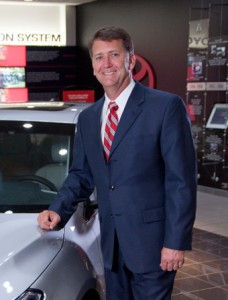 Steve Brown has been vice-president of Logistics Control since January this year
Steve Brown has been vice-president of Logistics Control since January this yearThe result is often a large, flexible trucking network. Toyota’s North American logistics design follows this pattern, with dedicated, direct trucking and milkrun loops.
However, established as these operations are, Toyota’s logistics management is in the midst of an important evolution that has transformed parts of its network on the continent. The Logistics Control team, based at the Toyota Motor Engineering and Manufacturing North America (TEMA) headquarters in Erlanger, Kentucky, has taken over or become more involved in the central planning and coordination of more logistics functions, including route engineering, integrated infrastructure management (such as crossdocks) and returnable container management.
Controlling the design of the carmaker’s trucking routes and frequency, which the plants had previously managed and outsourced to providers, means that Toyota can respond more quickly to supplier and market changes, says Steve Brown, vice-president of Logistics Control. “There are only about ten times a year that you have the chance to adjust your transport flows,” Brown says. “We have our own system and management for that, so we can do things much more quickly.”
Along with speed, TEMA managers stress the importance of using economies of scale between all plants and suppliers. By taking a network-wide view, Toyota has been able to increase direct routing, says Doug Adams, general manager of Logistics Control. “The advantage that we have by integrating the process is that we see all of the plants’ volume and routing structure. If it’s done independently, each plant only sees its own information,” Adams says.
"TEMA has a project across almost all of our plants this year to measure internal and in-plant logistics engineering, as well as the impacts from external providers. This flows into determining supplier locations, of which logistics is an increasingly important part" – Steve Brown, Toyota
TEMA has also taken more coordinated control over packaging, including monitoring returnable container loops. Logistics Control manager Brian Bold says the company has found opportunities in planning packaging return flows rather than relying on each plant in isolation.
“Vehicle model by model, we have shared suppliers across plants, and managing a mass of packaging assets across locations allows more flexibility rather than doing so at a plant level,” says Bold.
This more central approach and visibility over logistics is an important shift. While it does not take away from the primacy of the plant in TPS, or the kanban system that links assembly lines so tightly to suppliers, Toyota is trying harder to limit the costs and the risks in the wider supply chain, particularly following years when financial crises, recalls, tsunamis, flooding and currency movements disrupted production and profits. Brown stresses that TEMA is trying to do so while maintaining a “total supply chain view”, which means balancing capital expenditure, piece price, transport, inventory and packaging when making any decisions on sourcing or manufacturing. Logistics has grown to become more influential in these matters, he says.
“TEMA has a project across almost all of our plants this year to measure internal and in-plant logistics engineering, as well as the impacts from external providers,” says Brown. “This project activity flows into determining supplier locations, of which logistics is an increasingly important part.”

Toyota’s efforts to control supply chain risks and costs can be found across its global operations but the opportunities to capture economies of scale and make informed sourcing decisions are perhaps most significant in North America.
It is the company’s largest market at around 2.2m vehicles sold last year and likely to surpass 2.4m this year. North American production is second only to Japan, at 1.77m units last year. Toyota has vehicle, powertrain and component production in more than a dozen states, Canada and Mexico.
The company is investing throughout the supply chain, including increasing annual capacity by 180,000 vehicles, 316,000 engines and 120,000 transmissions in the US and Canada by 2015. That includes 50,000 units of the Lexus ES at Georgetown, Kentucky, which will be the first American-made Lexus. On top of these increases, Mazda’s plant in Salamanca, Mexico, will add 50,000 units of a small car for Toyota starting in 2015.
Following the turmoil of recent years, Toyota’s expansion strategy has an air of caution and appears aimed at both meeting customer demand and limiting supply chain risk. As it adds new models and production, the carmaker has been assessing supplier locations, and for that Brown says measuring total logistics and lead-time impacts is essential, and an important reason why TEMA is working so hard to measure logistics performance and cost. These considerations come together successfully at the Georgetown plant, where high localisation and a well-planned logistics flow allow more flexibility in the supply chain. For example, the plant allows changes to vehicles five days before production, with daily changes possible to paint colour.
“With the increased growth and the plans to build Lexus here, we want to limit cost but also make sure we are more efficient and flexible in our supply chain when we come out of these projects,” says Brown. “That comes back to being able to measure the total supply chain.”
Centralised and de-centralised logistics
One of the challenges to having such a view of Toyota’s supply chain – let alone controlling it – is the complexity of its management organisation. TEMA has central departments in Erlanger for Purchasing, Production Control and Logistics Control, with Brown’s team responsible for inbound logistics, packaging design, new model logistics and other areas. The central function has always been to monitor and manage providers and determine packaging requirements, working with Purchasing to procure the services. However, a great deal of logistics power has always sat with the plants, each of which is a separately incorporated entity at Toyota.
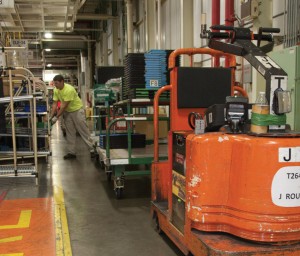
Many of the operational logistics functions are split between each plant’s Manufacturing and Production Control departments. The internal conveyance of parts and containers falls under Manufacturing, as do plant dock operations and the handling of empty containers. Parts ordering, production planning and the management of separation centres – which sort inbound material by dock or assembly lines, and subsequently sort empty containers for return legs– are functions of Production Control.
This setup reflects TPS in its degree of integration between manufacturing and supply at each plant. The Erlanger headquarters, on the other hand, is not attached to any manufacturing site but it must work to build links between the tightly run operations of each plant.
Until recently, each plant’s Production Control department also managed full truckload and milkrun deliveries, which it outsourced to lead logistics providers. The LLPs determined the routing based on volume and lead times and adjusting frequency to match the plant. TEMA managed the material that could not be moved or combined in full truckloads.
As TEMA already had an IT system and logistics engineering capabilities, the decision was made to both centralise the planning and to bring it in-house, starting with the plant in Princeton, Indiana. Doug Adams expects that all plants will be planned centrally within the next few years.
"Vehicle model by model, we have shared suppliers across plants. Managing a mass of packaging assets across locations allows more flexibility rather than doing so at a plant level" – Brian Bold, Toyota
Packaging design and empty return management are other increasingly important areas for TEMA. As the return flow of containers matches the trucks leaving the plant, their movement is now very much under TEMA’s view. Bold says that the group is working more with each plant’s Production Control and internal conveyance teams to improve the return process.
Brown’s Erlanger team also has central control of the total logistics chain for Toyota’s growing exports of parts from North America, including forecasting, parts release, packaging design and supplier preparation. As part of this, TEMA handles Free Trade Agreement (FTA) documentation and processes for exports.
Interestingly, Brown’s team is also responsible for the way that service parts are broken down and catalogued. They determine the best way a service part should be engineered for aftermarket distribution after each new model and major change. “If the dealer doesn’t like the level of a part, or if it’s too complex, then the engineers need to break it down further,” says Brown.
While the central functions assumed by TEMA are important, Bold says the department also has the important role of overseeing North American operations, with the opportunity to benchmark performance and recommend best practice. “We support the plants and provide the guidance across North America that is necessary whenever you have independent organisations as we do,” he says.
Brown adds that TEMA’s role can also be to help the plants communicate better between each other. “We help the plants to communicate monthly and talk about what they are doing in each location to find best practice and improvements,” says Brown. “Based on what we see, we then try to influence them and commonise operations where possible.”
A map of Toyota’s operations in the region goes someway towards explaining the advantages of centralising logistics (see map). There are now seven assembly plants that produce 12 models, plus Subaru’s plant in Lafayette, Indiana that builds Camrys, for which TEMA manages all the Toyota-related material (for production at Mazda’s Mexico plant, the current plan is for Mazda to manage the logistics).
Toyota has three engine plants that build 4-cylinder, V6 and V8 engines along with transmissions and powertrain parts. It has a further five component plants that make engine brackets, cylinder blocks, sheet metal parts, steering columns and other parts. The OEM’s most recent plant in North America is in Blue Springs, Mississippi, which opened at the end of 2011 and builds Corollas. Toyota ended production in 2010 at the NUUMI joint venture with General Motors in California.
In North America alone, Toyota spends about $26 billion each year on parts and $1.5 billion in services from 660 suppliers across more than 30 states, Canada and Mexico. About 75% of its inbound material is sourced in North America, with a large concentration of suppliers around Midwest states, including Kentucky, Ohio, Michigan and southern Ontario, as well as the southeast. Although it has some suppliers in Mexico, Adams says that the company has not seen a migration south. “There was a push for that a few years ago, but our new model launches have mainly used our existing supply base,” he says. 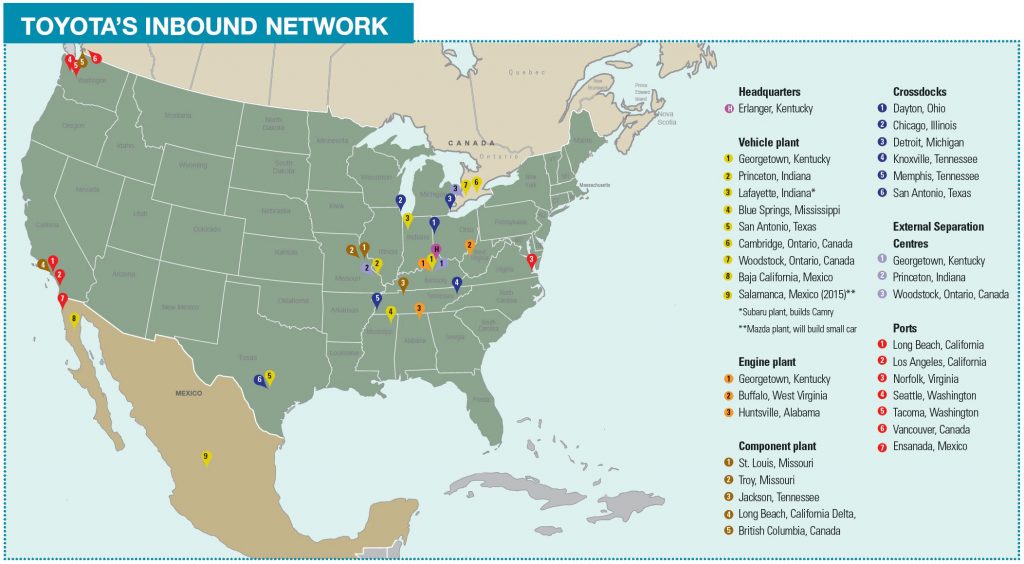
Defining trucking routes
Toyota moves material through a vigorous trucking network across the continent, which TEMA’s central routing team adjusts about ten times a year – a higher frequency than most companies tend to do in the automotive industry. “We’re trying to meet the fluctuations of the vehicle market as it swings from month to month,” says Brown. “If we don’t follow that quickly, we could lose cube efficiency or risk blowing out the trailer as volumes go up.”
The inbound network is highly planned and synchronised, and designed for material to be touched a minimum number of times. The most efficient flow is what Toyota calls a ‘direct route’, which is from one supplier in a full truck or else a truck that makes multiple stops before going direct to a plant.
Some plants have multiple lines and docks, such as Georgetown (see below). In such cases, Toyota uses ‘separation centres’ near the plant to manage the flow between truckload and the assembly line. For these routes, carriers collect material by milkrun before delivering full loads in sequenced timeframes to the separation centres, which sort freight according to dock or course code, and shunt trailers to the factory door.
The third mode for trucking is regional crossdocks. For longer distance or smaller suppliers that cannot go direct to the gate or separation centre, trucks collect the material from suppliers and deliver to crossdocks (movements that Toyota calls ‘sub-routes’). The crossdocks work the same way as the separation centres, except the freight is sorted according to different plants and trucked by ‘main routes’ to the factory gate, or again to separation centres in some cases.
External separation centres and crossdocks are both outsourced to providers. All the facilities are dedicated to Toyota, except for two crossdocks that can be shared in Knoxville, Tennessee and Dayton, Ohio. “Our vendor can bring in any company it wants to these crossdocks, although the freight must be handled separately,” says Adams.
Less than 1% of Toyota’s freight moves less-than-truckload, says Bold, which is made up of low volume and long distance suppliers. There is no planned air freight in its network, adds Brown. “We don’t plan any air freight but of course we have to use it sometimes – we certainly did as we recovered from the earthquake,” he says.
Rail struggles to keep up
Toyota uses very little rail in North America, as the mode usually cannot match the carmaker’s strict routing schedules. Only the Baja plant in Mexico, which builds the Tacoma pickup truck, relies on rail. Material is consolidated in Chicago and in San Antonio and railed from both points to Mexico.
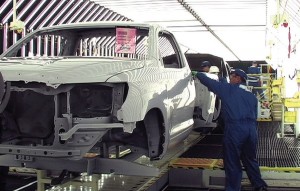
Toyota also used to move by rail from its San Antonio plant to the Midwest but as the carmaker ramped up production last year, it found that rail could not keep up with supply. “We switched from rail to over-the-road to get more flexibility,” says Adams. “We learned a lot about lead times during that period and how flexible our supply systems were and weren’t. Rail just couldn’t keep up.”
Brown says that Toyota would like to look more into rail, and it is currently considering a new lane for backhauls out of Baja back to Texas, as the Baja plant builds truck beds used for the Tacoma truck built in San Antonio and shares other suppliers. “We need to look more at rail but the fluctuations in lead times are a concern for us,” says Brown.
Import/export
Toyota imports parts from overseas to North America, mainly from or via Japan. It receives about 160 full containers per day – nearly 80,000 TEUs per year. The total to each plant varies considerably; at Georgetown, where the Camry and Avalon are around 85% localised, it is only 13 containers per day, says Brown.
Almost all parts from Asia are repacked and consolidated in vanning centres in Japan, then imported to North America; the exception is Brazil, from which Toyota imports directly to the port of Norfolk. TEMA does not manage imported containers; Toyota Motor Corporation in Japan buys the sea freight and each plant contracts carriers to move it from ports. Containers are only opened at the factory dock.
By contrast, exported parts are under Brown’s responsibility at TEMA and he says they are growing to Russia, Japan, Brazil, Central America, Europe and Australia. Toyota currently exports about 1,500 containers per year from North America – about 3,000 TEUs.
Most exported parts, including those for FTA projects, are consolidated at crossdocks in San Antonio and Chicago. San Antonio is 100% pallet-based shipping, says Adams, so the crossdock receives freight and loads it directly into sea containers.
Chicago has both full pallet and module shipping. Workers break down pallets by box type and put them in modules for some customers, such as for Toyota’s CKD production in Russia, says Adams.
Some FTA projects move in other ways. TEMA ships leather from Mexico to a provider that has a free trade zone in Laredo, Texas, and from there moves it onward to Japan.
"The advantage that we have by integrating [route design] is that we see all of the plants’ volume and routing structure. If it’s done independently, each plant only sees its own information" – Doug Adams, Toyota
Changing with the supply chain
Taking over logistics engineering and routing was an important development for TEMA and one of the reasons that it did so was to keep a closer eye on the network. TEMA does route analysis ten times per year to respond to production changes, and runs total network studies at least once a year to test consolidation points. “That is really part of the benefit of having this function in-house, so that we can regularly see what’s happening across all the plants,” says Brown.
New or major model changes usually lead to supplier changes and thus reconfigurations in the network, says Brown. The introduction of Lexus to Georgetown is an example; TEMA has already done studies as to what the change could mean. “Our latest study went out to 2016 based on the little that we already know,” says Adams. “But we need to look out far enough to make sure that any
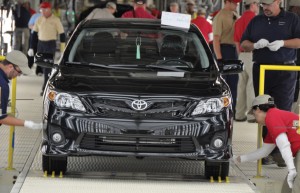
decision made today won’t be a negative in one or two years.”
The supply base changes frequently, but it happens most dramatically when plants open or close. Toyota’s supply base saw a re-balancing with the start of Corolla production in Mississippi. While the Mississippi plant was built before the decision to close NUMMI, which previously built the model, the centre of gravity for Corolla’s supply base has today moved much more to the south and the Midwest.
In assessing the supply shifts, TEMA made considerable network changes. The Georgetown plant previously housed both a separation centre for the plant and a large regional crossdock to serve other locations but Brown says that with hundreds of suppliers concentrated in the Midwest, there was opportunity to move more material direct to the plant.
TEMA decided to end the regional crossdock activity at Georgetown and use the space entirely as a separation centre. The buildings are now used to receive around 315 suppliers and to process and return empty containers (see below). The integrated crossdocking operations were moved to Knoxville and Dayton.
These changes, along with other central routing decisions, have considerably rebalanced the percentage of freight moving direct as compared to sub-routes. Whereas a few years ago the split between direct routes and crossdocks was 50-50, in todays’ network only 8% move through a crossdock. The combination of direct (59%) and separation centre (33%) means that 92% of freight goes either right to the dock door or is re-sorted close to the plant. That means less handling of parts and a substantial reduction in miles. “We’ve made huge improvements with the changes implemented over the past few years,” says Adams. “The less touch the better.”
About 60 miles south of TEMA’s headquarters in Erlanger, and just a few miles from the placid, blue grass horse farms of Lexington, is Georgetown, where Toyota’s second largest global plant produces about 2,100 cars and 2,200 engines per day. Toyota Motor Manufacturing Kentucky (TMMK), established in 1986, plans to increase capacity by 10% to 550,000 units by 2015 for production of the Lexus ES. The plant currently builds about 80% of the Camrys sold in North America and is the only site in the world that builds the Avalon and Venza.
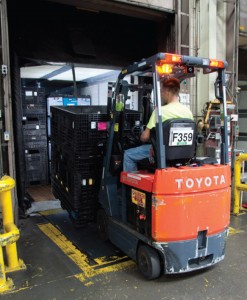
The site is characteristic of Toyota in several ways, including its vertical integration. Besides engines, TMMK builds transmissions, axles, fuel tanks and stamping dies. A plastic shop on site makes 35,000 parts per day, including bumpers, instrument panels and door trims. As well as moving to the assembly line just in time, many of components and dies are shipped to other Toyota plants.
Nearly 450 trucks arrive at TMMK with material each day, including 13 containers of imported parts. Imported material is held at the plant’s south receiving dock, while the rest either goes to gates for one of the plant’s 16 assembly lines, or else to the Kentucky Separation Centre (KSC), next door to the engine plant.
Internally, TMMK has some of the most efficient logistics in the Toyota network. It is highly automated, using a fleet of more than 100 automatic guided vehicles to move raw materials and stamping in the plant as well as sub-assembled parts to the assembly line.
KSC – linking good logistics
The KSC was previously a regional crossdock that served Georgetown and fanned out material to other Toyota plants, but TEMA’s network analysis saw the opportunity to route more direct deliveries to TMMK, so dedicated the site to plant material.
Since it was previously a crossdock, the KSC is unusually large for a separation centre, with one building for inbound freight and another for handling empty containers. “The disadvantage is there are longer cycle times,” says Jason Stone, assistant manager for Production Control at TMMK. “But we have also found that this means staff members take more ownership in their tasks.”
The KSC, like all external separation centres and crossdocks, is outsourced to a provider, in this case Transfreight. Ryder and Rush do the road haulage to the KSC, while Ryder alone does the onsite shunting of trailers.
The KSC receives 175 trailers each day carrying 8,900 cubic metres of freight from 315 suppliers. It receives about 40% of the freight arriving to TMMK. According to Stone, trucks have 30-minute windows to arrive with freight and unloading is done in 20-minute intervals. Each pallet arrives with a placard designating the material, planned arrival and unloading time, as well as its route and parking location in the KSC. Transfreight teams unload the trailers and move them to parking slots – which are ordered according to gate or line destinations – from where they will later be loaded for plant delivery.

On the other side of the placard is the return information for the packaging, which follows the reverse flow to the parts. “Staff also monitor ‘non-conformant’ packaging,” says Stone. “That could be a pallet that has unstable balance, is damaged or has other issues. We report that to TMMK.”
Transfreight uses Toyota’s Freight Verification Management system (FVM) for unloading and loading. Workers use a handheld device to scan incoming pallets for entry, after which they apply a new barcode to give it a unique designation on site (a process that will be eliminated in a new system Toyota is developing, says Stone). The device also shows the planned loads versus what has been unloaded; if they don’t match, the system locks and the manager must be consulted.
Aside from this system, the KSC uses mainly visual queues to guide staff. Schedules and scorecards of team performance are next to each loading dock. A loading plan uses simple illustrations to show which number pallet to load first. Toyota has also recently introduced an ‘andon board’ in the KSC, which displays each team’s progress by lighting up either green (for on time), amber (for approaching late) or red (for late). These are similar to andon cords in plants that light up where workers are having issues. “The colours are not to criticise each team but to highlight where a potential problem might be,” says Stone.
The tasks here are relatively simple, but they are essential to TPS. The high volume and efficient throughput are part of managing the heijunka of production, and maintaining the most efficient truck routes to Georgetown.
Packaging loops – a consumer and a supplier
TEMA has several packaging projects for both returnable containers and designing standards. While TEMA’s central viewpoint is again important, packaging touches so many parts of the supply chain that it’s essential to work in concert with plants, Production Control and third party providers. In many ways TEMA’s role is to track the KPIs and processes across the chain.
“Packaging is a close collaboration between the internal and external side,” says Bold. “Containers might be a Production Control function at the plant, but the team member handling the box is an internal logistics member.”
Toyota’s container loop is a huge operation, as 98% of the packaging in North America is returnable. Trailers that deliver components are reloaded with empty boxes to return to suppliers or crossdocks. For Bold, this loop means that Toyota is not just a customer receiving parts, but also a supplier expected to return packaging to tier ones. “So, as a supplier, we have to monitor that we are delivering our output – that empty box – in the right quantity, right place and in a clean and working condition,” says Bold.
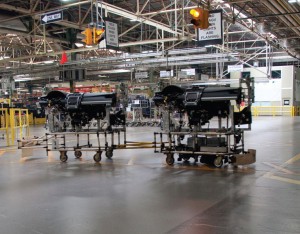
Toyota does not use any outside providers to manage its packing loops. In terms of ownership, Toyota’s Canadian operation owns the supplier packaging, while in the rest of North America the plants control the packaging, but the asset is ‘transferred’ to tier one suppliers and carried on their books, says Bold. As with other OEMs, the carmaker faces issues with tracking and losing boxes, but somewhat typical for Toyota, it does not use any automated or barcode scanning system to track them (although it does have a loading verification system for parts at crossdock and separation centres). TEMA has instead worked on improving the loops through more central oversight and monitoring. Likewise, the network integration across North America means that packaging assets are shared more across locations, which makes proactive management necessary.
Brown believes there are more opportunities to reduce waste in returnable packaging, particularly as TEMA creates a detailed picture of where assets go missing or are mishandled. “We’re not bad at handling the returns, but measuring and identifying problems is where we are focused lately,’ Brown says. “The plants have reacted very positively to the information we’re providing about the returns and are also working hard to improve. We’ve got a way to go but we’re moving in the right direction.”
Designing rack standards
Logistics Control has always been involved in packaging design and the Erlanger team is now doing more to set common standards for designs such as metal racking used across plants. TEMA packaging engineers usually start their work four years prior to model launches, studying the logistics issues and working with plants on handling and supply. They then try to influence the part’s designers so that its shape or assembly matches the most optimal packaging. “Once we’ve exhausted those opportunities, we look at the packaging design itself,” says Bold. “We look at how can we orientate the box and what types of material we should use.”
Adams says the packaging group has come far in its ability to influence part designers. “Parts designers are now very aware of the impacts of design on logistics,” he says.
Over the last two years, TEMA has worked on common packaging for complex equipment such as metal racking. The first major project was a rack to move engines built at Toyota’s plant in Alabama, and the second a rack for automatic transmissions from the West Virginia plant.
Toyota had previously used different racks for these parts, including a domestic version and one imported from Japan. Bold says that the domestic one for transmissions was “a battleship of a rack” that worked well in the plant but was heavy and poorly suited for transport – a problem since the West Virginia plant moves transmissions to both Canada and Kentucky. The Japanese version had high pack density but poor ergonomics in the plant. The new standard combines the pack efficiency of the overseas rack but is easier to handle and to transport. “These were significant projects and TEMA is now looking at what other commodities we can apply common standards for,” says Bold.
TEMA is also studying how it might use more returnable packaging for overseas movements. Packaging for Japanese imports is a global standard and 95% returnable. However, North American exports use almost entirely expendable packaging. Brown says TEMA is looking at new designs and whether it can use more of the Japanese packaging for export.
Ever concerned about environmental impact, Toyota was among the first carmakers to track emissions for logistics. This year, TEMA will expand tracking from road-based emissions to include other modes, including air freight, according to Doug Adams. “We are also tracking our waste stream for packaging, cardboard and wood skids [pallets],” says Adams.
Besides using routing and consolidation to lower miles, TEMA is pushing carriers to reduce their emissions, including holding workshops on fuel efficiency.
“We’ve held sessions at our proving grounds in Phoenix, Arizona to demonstrate things such as how tractor trailers might save fuel in driving and maintenance,” says Adams.
Steve Brown says TEMA tracks emission and fuel reduction as KPIs for carriers. As well as pushing for improvements, he admits that Toyota might be willing to share investment on technology to reduce fuel. “It might require some investment but we would be open to that if it resulted in a mutual benefit,” says Brown.
Facing and shaping the future supply chain
As Toyota plans for growth over the coming years, it could face some constraints for logistics. TEMA works with ten carriers, as well as with crossdock providers, and Adams finds some have been slow to invest in capacity as the economy recovers. “There are also new government regulations coming into force on driving hours that could put further constraints on the workforce,” says Adams. “We’re working intimately with carriers to understand how they will cover that.”
Brown points to the importance of training, both in-house at Toyota as well as for logistics providers. “We have to make sure that the future supply chain leaders at Toyota and at external partners are trained in total supply chain thinking,” says Brown. “We are using some of our resources at TEMA to work with those in the plant and our partners.”
Many projects for Logistics Control come back time and again to informing total supply chain costs. When choosing suppliers or locations, for example, understanding packaging performance could be as important as transport costs.
“We’re trying to integrate the total logistics concept to those types of decisions,” Bold says. “It means we are not just looking at the pack density of a container or box, but what is the cost to handle it, convey it internally, manage its return, etc. We’re trying to visualise that total landed cost for choosing supplier locations and ‘make-versus-buy’ decisions.”
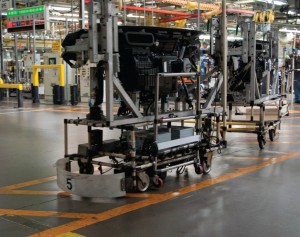
Capturing this information is critical to Toyota. The company has a clear strategy to localise more in North America but at the same time no supply chain decision is as simple as choosing local over regional, or even global suppliers. Brown points out that sometimes it is worth raising logistics costs to save on capital expenditure, while it can also work in the opposite way. “Capital investment can be offset by reduced logistics costs,” he says.
Delivery performance, inventory or lineside handling can often tip the scale in a decision on where to source, or whether to manufacture a part in-house.
“We want to track data on things like shortage calls, overflow, arrival and dock-load scheduling,” says Brown. “These measurements will help capture things like how many missed vehicles or [how much] downtime resulted from logistics. You want it to be zero, but the truth is it happens and you need to understand why.”
The point is to see and to quantify the logistics implications of any decision, as those logistics can in turn have big impacts on other operations. That is why, further centralisation aside, an important part of what Erlanger does will continue to be tracking and measuring logistics – then explaining what it means to purchasing and manufacturing.





